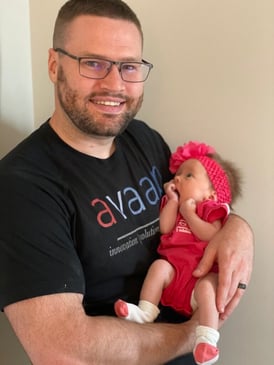Data Storytelling: Visualizing the First Month of Paternity Leave
The month before the birth of my first child, a coworker shared a tweet with me where a couple leveraged Glow Baby app data to visualize the paternity leave experience in an augmented reality software. The Tableau nerd in me couldn’t resist, and I set out to collect and visualize my own paternity leave data in my preferred software, Tableau.
 Avaap offers a generous paternity leave, and I had the naive perception that I would have a lot of free time on my hands. HA! Nevertheless, baby Vera was born, my wife obliged, and we began collecting data in the Glow Baby mobile app. While we started using this app to collect data for my viz, it ended up being really helpful to manage feedings and diaper schedules, as well as comparing data with other app users. I highly recommend to new parents!
Avaap offers a generous paternity leave, and I had the naive perception that I would have a lot of free time on my hands. HA! Nevertheless, baby Vera was born, my wife obliged, and we began collecting data in the Glow Baby mobile app. While we started using this app to collect data for my viz, it ended up being really helpful to manage feedings and diaper schedules, as well as comparing data with other app users. I highly recommend to new parents!
After a month of logging every feeding and diaper change in the app, I felt that we had a meaningful amount of data and dumped all of it into Tableau Desktop. As with any visualization project, I started by identifying questions that should be answered with the viz. These would become success criteria in a professional setting.
I came up with the following:
- What was the most surprising part of the first month? What would I want other new parents to know before embarking on their own parental leave?
- How many minutes were spent feeding this child, and how many cumulative feedings did she require in the first month?
- How many diapers did we change, and how many diapers should a prospective parent be prepared to change in the first 30 days?
- How much free time did my wife and I have between feedings and diaper changes?
- How did Vera’s weight compare with other babies?
With these questions in mind, I began to visualize the data. Partially inspired by the tweet mentioned and by the graphs available in the app, I was able to put together a viz on Tableau Public featuring nifty bottle-symbol Gantt, isotype time series, combination bar/line, and percentile-fan line graph types. I also made a conscious effort to lean heavily on the Gestalt principles of visual perception and used color and white space strategically to produce an aesthetically clean design. The exercise was a fun experiment and a worthwhile journey into the art of the possible with Tableau. I hope it answers some questions for new parents and demonstrates the ever-growing capabilities of this awesome data visualization tool!

